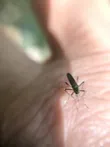
Harmful Effects of Washino's willow pool mosquito
A species of Mosquito, Also known as Washino's willow mosquito
Washino's willow pool mosquito bites can cause irritation and may transmit diseases, impacting human with varying severity, from mild annoyance to serious risks in disease-endemic regions.
Harmful Facts About Washino's willow pool mosquito
What Type of Pest Is Washino's willow pool mosquito?









AI entomologist in your pocket
Scan QR code to download

